Fortune sometimes favors the impulsive.
For years, we’ve been toying with joining PBS. The cycle of fund drives that present interesting specials on our local station (Channel 9, KETC) both annoys us for the interruptions and for the twinges of conscience triggered because we feel like we’re not doing our share to support it. The question has always been, when to do it?
Because they always offer gift packages to sweeten the deal and we’ve been tempted. Last spring, though, they came through with something we couldn’t turn down—tickets for a dinner train.
Both of us like trains, though we have ridden them fewer times than the fingers on one hand. There’s a romanticism about them that appeals to both of us, even though we don’t frequent them. (We took one train trip to Chicago, which was novel and unromantic, and I’ve taken the train from St. Louis to Kansas City twice—well, once, really, since one of those trips was during a time when the line was coopted by freight line after a flood and my ticket was fulfilled by bus—and none of those trips endeared us to the fact of train travel. But the idea lingers on and one day we may well do a cross-country in a sleeper.)Â So for our pledge of X dollars, we found ourselves with a guidebook to such trains across America, a DVD about them, and a pair of dinner tickets for the Columbia Star.
We’d planned to do this in mid-August, but fate intervened in the form of a ruptured appendix and we had to delay until I could actually sit through a three-hour gourmet meal on a rolling vehicle. So it ended up in mid-October.
Which was kind of ridiculous, really. After all, part of the novelty—we assumed—was the passing scenery. After seven in the evening in mid October, what exactly would there be to see? “Oh, we have floodlights mounted on the cars to light the way,” I was told by the charming scheduler when I asked. Hmm.
In any event, we were getting special treatment. The tickets were time-limited and we’d delayed past their due date. I explained the reasons and pity was taken. We were slated for October 20.
It’s a hundred and twenty plus change miles from St. Louis to Columbia, so we arranged to make a weekend of it and stay with out friend John in Jefferson City. The weekend turned out to be spectacularly beautiful, the drive down Highway 50 relaxed, and peppered with scenic delight.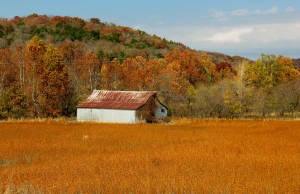
We ambled from Jefferson City up 63 to Columbia and found our destination easily enough (earlier, Donna had fun playing with Google maps on John’s iPad, finding the location). It was off in a combination of old farmland and industrial development that was still active but had seen more plentiful times. The Columbia Star terminal looked nicely restored and a large parking lot filled with cars and guests as the sun headed down for the day. (The range of vehicles ran from modest—older Nissans—up to opulent—a couple of new Lexus and Mercedes.) (The plural—would it be Lexuses or Lexi?) We walked around the train, admiring it like some great antediluvian beast brought back from a cloud-obscured plateau, uncertain of its provenance but impressed by what we thought we knew of it, both its power and its rarity.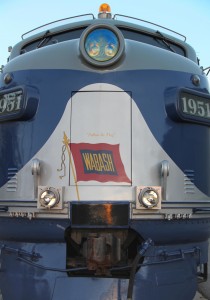
The dinner train phenomenon, as we learned from the PBS special that brought us to this place, is widespread and one of the chief ways many old, historic trains have been preserved. Some of them run quite a long distance and they are day-long excursions. This one runs between Columbia and Centralia, rumbling at a stately pace for about three hours, there and back, long enough for the repast on offer.
People continued arriving after we parked, leaving ample time to inspect it. The gathering on the parking lot reminded me of scenes on docks, crowds facing the ships about to take them away. A line of track acted as psychological barrier—a steel rope in the tarmac—keeping onlookers safely separated from the docile beast until its handlers declared it safe to approach.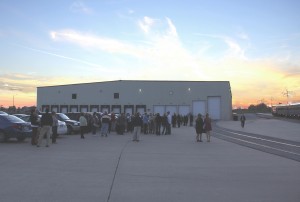
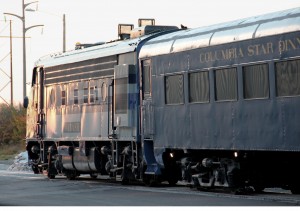
But a few minutes before seven, people with clipboards began sorting us out, allowing us to board, directing us to tables within the finely-restored dining cars.
The lack of scenery beyond the twenty or thirty feet the floodlights illuminated was ostensibly compensated for by the fact that people were placed at tables with strangers—unless you had a larger group—with whom you were forced to either engage pleasantries and become cordially acquainted or stoically endure if you’re not the gregarious sort. I admit to having difficulties in that department and were we to do this again we’d make plans with another couple at least.
But to be fair, the couple with whom we were paired was pleasant, the conversation, while shallow, was not without moments of shared laughter and some interest. After fifteen minutes, though, it was also clear that we really lacked anything very much in common with them and while it was not awkward it was not the kind of experience one would necessarily wish to repeat.
But the food!
Our waitress brought our drinks and then took our opening orders (the main courses were already set in advance) and I decided that this was excellent training for them—serving on a moving platform that rocked (gently, yes, but nevertheless) and none of them spilling a bit, drop, or particle.
There was a pulled-pork on cornbread appetizer, followed by an acorn squash bisque that…well, I’d never tasted anything quite like it. I could have done with a full bowl of it and been wholly content.
That would have been a shame, though. The main course—there were several to choose from—was superb. Now, both Donna and I have high standards for prime rib. We were spoiled. All joking aside, the best prime rib either of us ever had was at the long-defunct St. Louis Playboy Club. I’m serious. The chef there could turn prime rib out like ambrosia. We’ve had close before, but never better. This was probably as good. It was wonderful.
We trundled along through small town Missouri. After our trip to Chicago, I decided that contemporary passenger trains really take you through America’s back yard. That’s pretty much what you see, the back end of what is hidden from the highways and main streets. This was no different. However, some people whose houses stood along the line knew the schedule of the train and were outside, with fires going, a few barbecues still underway, waving as we passed by.
Our table mates imposed on us to take a picture of them and we asked the same in return, something we almost never do. But I felt that this deserved a bit of commemoration. There was a moment of intimidation when I handed across my Canon 60-D, but I’d already set it up and pointed to the button. The picture was successful.
We drove back in a state of satisfaction, heads filled with nothing but agreeable impressions and an unspoken decision to do this again. That’s as good recommendation as an establishment can get, the promise of repeat business. It helps that we think the idea behind it—preserving a bit of history—is a worthwhile one.
But it is the food that makes it worth doing.
Bon appetite!
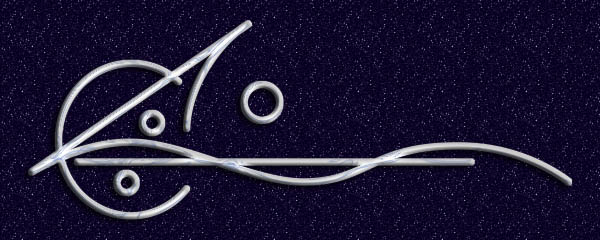
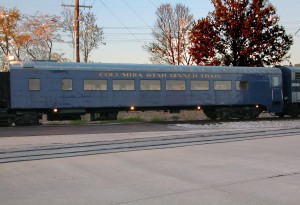
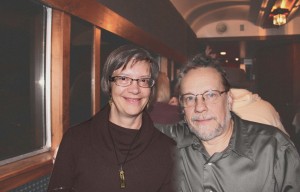
We had a comparable experience in celebration of Judith’s birthday last April. I really appreciate your detailed description and am happy that the word is getting around about the dinner train. There is very little local publicity for it, so we have wondered at times whether it was even in operation. Your confirmation is very welcome news. All best, Tom